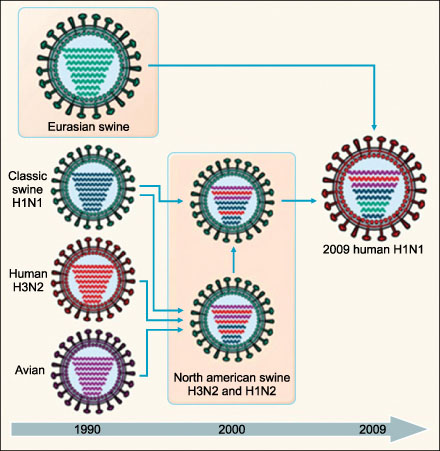Tuberc Respir Dis.
2011 Apr;70(4):285-292.
Influenza Associated Pneumonia
- Affiliations
-
- 1Department of Internal Medicine, Chung-Ang University College of Medicine, Seoul, Korea. jykimmd@cau.ac.kr
Abstract
- After an outbreak of H1N1 influenza A virus infection in Mexico in late March 2009, the World Health Organization raised its pandemic alert level to phase 6, and to the highest level in June 2009. The pandemic H1N1/A influenza was caused by an H1N1 influenza A virus that represents a quadruple reassortment of two swine strains, one human strain, and one avian strain of influenza. After the first case report of H1N1/A infection in early May 2009, South Korea was overwhelmed by this new kind of influenza H1N1/A pandemic, which resulted in a total of 700,000 formally reported cases and 252 deaths. In this article, clinical characteristics of victims of H1N1/A influenza infection, especially those who developed pneumonia and those who were cared for in the intensive care unit, are described. In addition, guidelines for the treatment of H1N1/A influenza virus infection victims in the ICU, which was suggested by the Korean Society of Critical Care Medicine, are introduced.
MeSH Terms
Figure
Reference
-
1. Reed C, Angulo FJ, Swerdlow DL, Lipsitch M, Meltzer MI, Jernigan D, et al. Estimates of the prevalence of pandemic (H1N1) 2009, United States, April-July 2009. Emerg Infect Dis. 2009. 15:2004–2007.2. Miller E, Hoschler K, Hardelid P, Stanford E, Andrews N, Zambon M. Incidence of 2009 pandemic influenza A H1N1 infection in England: a cross-sectional serological study. Lancet. 2010. 375:1100–1108.3. Updated CDC estimates of 2009 H1N1 influenza cases, hospitalizations and deaths in the United States, April 2009-April 10, 2010. Centers for Disease Control and Prevention. c2010. cited 2010 June 7. Atlanta, GA: Centers for Disease Control and Prevention;Available from: http://www.cdc.gov/h1n1flu/estimates_2009_h1n1.htm.4. Dawood FS, Jain S, Finelli L, Shaw MW, Lindstrom S, et al. Novel Swine-Origin Influenza A (H1N1) Virus Investigation Team. Emergence of a novel swine-origin influenza A (H1N1) virus in humans. N Engl J Med. 2009. 360:2605–2615.5. Bautista E, Chotpitayasunondh T, Gao Z, Harper SA, Shaw M, et al. Writing Committee of the WHO Consultation on Clinical Aspects of Pandemic (H1N1) 2009 Influenza. Clinical aspects of pandemic 2009 influenza A (H1N1) virus infection. N Engl J Med. 2010. 362:1708–1719.6. Butler D. Portrait of a year-old pandemic. Nature. 2010. 464:1112–1113.7. Louie JK, Acosta M, Winter K, Jean C, Gavali S, Schechter R, et al. Factors associated with death or hospitalization due to pandemic 2009 influenza A(H1N1) infection in California. JAMA. 2009. 302:1896–1902.8. Hewagama S, Walker SP, Stuart RL, Gordon C, Johnson PD, Friedman ND, et al. 2009 H1N1 influenza A and pregnancy outcomes in Victoria, Australia. Clin Infect Dis. 2010. 50:686–690.9. Creanga AA, Johnson TF, Graitcer SB, Hartman LK, Al-Samarrai T, Schwarz AG, et al. Severity of 2009 pandemic influenza A (H1N1) virus infection in pregnant women. Obstet Gynecol. 2010. 115:717–726.10. Webb SA, Pettilä V, Seppelt I, Bellomo R, Bailey M, et al. ANZIC Influenza Investigators. Critical care services and 2009 H1N1 influenza in Australia and New Zealand. N Engl J Med. 2009. 361:1925–1934.11. Mandell LA, Wunderink RG, Anzueto A, Bartlett JG, Campbell GD, Dean NC, et al. Infectious Diseases Society of America/American Thoracic Society consensus guidelines on the management of community-acquired pneumonia in adults. Clin Infect Dis. 2007. 44:Suppl 2. S27–S72.
- Full Text Links
- Actions
-
Cited
- CITED
-
- Close
- Share
- Similar articles
-
- A Case of Severe Influenza Infection in a Child with Nephrotic Syndrome on Steroid Therapy
- Avian Influenza
- Clinical Evaluation of Aspoxicillin on Patients with Pneumonia
- A Case of Novel Influenza A (H1N1) Virus Pneumonia Complicated Pnemomediastinum and Subcutenous Emphysema
- Vaccines for Prevention of Otitis Media and Pneumonia in Children


